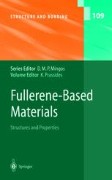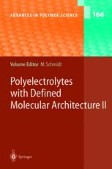Search
Search Results
-
Structural and Electronic Properties of Selected Fulleride Salts
The study of strongly correlated electron systems is at the forefront of contemporary condensed matter research because such materials, which include...
-
Thermal Spin Crossover in Mn(II), Mn(III), Cr(II) and Co(III) Coordination Compounds
This chapter considers thermal spin crossover occurring in transition metal compounds other than those of Fe(II), Fe(III) and Co(II). Unusual...
-
Isokinetic and Isoequilibrium Relationships in Spin Crossover Systems
A thorough statistical mechanical analysis of sources of variations and correlations in ΔE 0 and ΔS 0 of spin crossover...
-
Towards Spin Crossover Applications
In this chapter we attempt to review the potential for the application of the spin crossover (SCO) phenomenon in various domains, such as molecular...
-
Triplet Emitters for OLED Applications. Mechanisms of Exciton Trap** and Control of Emission Properties
Triplet emitter materials present attractive possibilities for optimizations of organic/organometallic light emitting diodes (OLEDs). This is due to...
-
Intermolecular Interactions via Perturbation Theory: From Diatoms to Biomolecules
This article is devoted to the most recent, i.e. taking place within the last few years, theoretical developments in the field of intermolecular...
-
Structural Aspects of Layered Double Hydroxides
Layered double hydroxides (LDHs) have been known for a considerable time and have been widely studied. The basic features of their structure,...
-
n-Body Decomposition Approach to the Calculation of Interaction Energies of Water Clusters
A new methodology is proposed in which large basis set MP2-level calculations can be extended to water clusters with as many as 50 monomers. The...
-
Multiporphyrin ArraysAssembled Through Hydrogen Bonding
Although relatively weak in isolation, composite H-bonds can be used as an advantage for the assembly of relatively robust and well-defined arrays...
-
Axial Coordination to Metalloporphyrins Leading to Multinuclear Assemblies
The use of axial coordination to metalloporphyrins is discussed on the basis of constructing multinuclear complexes. Starting with single...
-
Beads Arraying and Beads Used in DNA Chips
The present article draws a general picture of the bead assisted DNA immobilization on chips. The authors wish to present these systems since...
-
Liquid Chromatography under Critical and Limiting Conditions: A Survey of Experimental Systems for Synthetic Polymers
At the interface between the entropic size exclusion separation and the enthalpydominated liquid adsorption chromatography it is possible,...
-
Conformation and Phase Diagrams of Flexible Polyelectrolytes
The present article addresses the dilute solution behavior of two different polyelectrolyte systems: Aqueous solutions of quaternized...
-
Stiff-Chain Polyelectrolytes
Rod-like polyelectrolytes Rod-like polyelectrolyte represent ideal model systems for a comprehensive comparison of...
-
Specific Structures Enabled by Metallocene Catalysis in Polyethenes
This chapter briefly describes the history of metallocene polymerisation catalysts. The behaviour of metallocenes, particularly in copolymerisation...
-
Electrochemical Adsorption Technique for Immobilization of Single-Stranded Oligonucleotides onto Carbon Screen-Printed Electrodes
The data reported in literature demonstrate that screen-printed carbon electrodes are very suitable for supporting nucleic-acid layers and to...
-
Electronic Structure and Energetics of Fullerites, Fullerides, and Fullerene Polymers
Cohesive mechanisms and electronic properties of C60 fullerites, various C60 compounds including superconducting alkali fullerides and alkaline-earth...
-
Ligand-Driven Light-Induced Spin Change (LD-LISC): A Promising Photomagnetic Effect
“Ligand-driven light-induced spin change” (LD-LISC) is a photomagnetic effect based on the modulation of the ligand-field strength of a suitable...
-
Modeling the hydration of proteins at different pH values
The atomic coordinates of proteins, for example, of the enzyme lysozyme as a small model protein, can be used for calculating analytically the exact...
-
Rhenium-Linked Multiporphyrin Assemblies:Synthesis and Properties
Re(CO)5Cl readily reacts with pyridine-derivatized porphyrins to give molecular squares or planar dimers featuring fac-Re(CO)3(Cl) corners....
